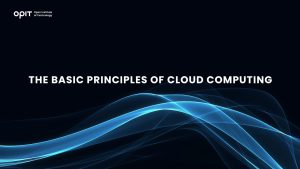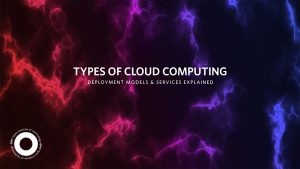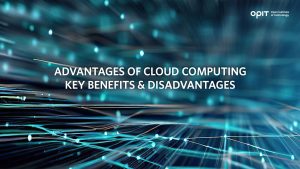
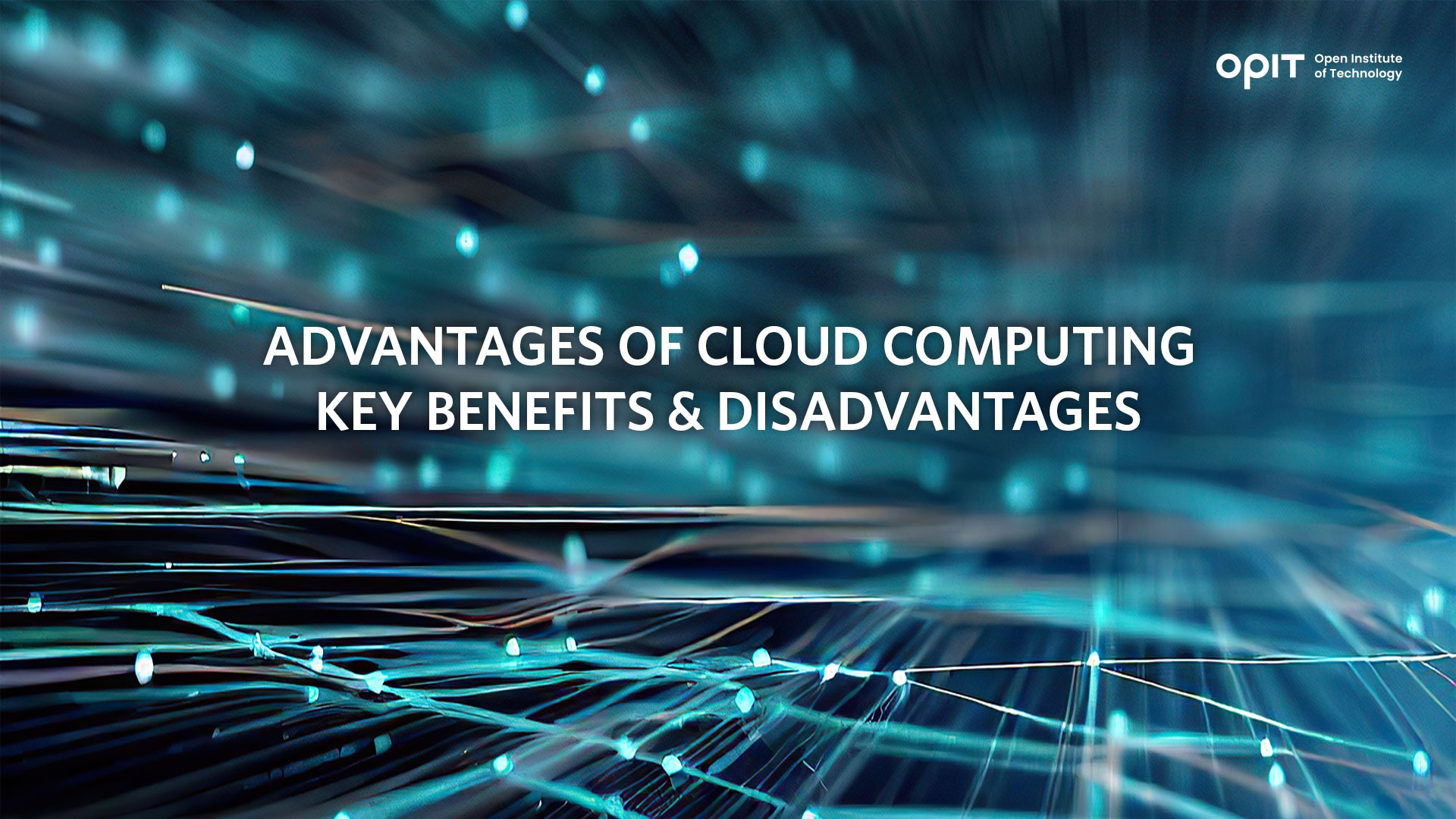
Gone are the days when you had to store boxes of documents in your office. Salvation came in the form of cloud computing in the 2000s. Since then, it’s made a world of difference for businesses across all industries, increasing productivity, organization, and decluttering the workspace. More importantly, it allows businesses to reduce various expenses by 30%-50%.
Cloud computing has countless benefits, but that doesn’t mean the technology is flawless. On the contrary, you should be aware of several disadvantages of cloud computing that can cause many problems with your implementation. Weighing up the pros and cons is essential – and we’ll do precisely that in this article.
Read on for the advantages and disadvantages of cloud computing.
Advantages of Cloud Computing
The cloud computing market is worth more than $540 billion. The main reason being that over 90% of all companies use some form of this technology. Here’s why they rely on cloud-based platforms.
Cost Efficiency
One of the greatest benefits of cloud computing is that it’s cost-efficient and allows you to reduce business expenses on three fronts.
Reduced Hardware and Software Expenses
You don’t need physical hardware to store your documents if you have a cloud computing platform. Likewise, the technology eliminates the need to run multiple software platforms because you can keep all your files in one place.
Lower Energy Consumption
In-house storage solutions can be convenient, but they consume a lot of electricity. Conversely, cloud computing systems help companies increase energy efficiency by over 90%.
Minimal Maintenance Costs
Maintaining such platforms is straightforward and affordable as cloud computing doesn’t involve heavy-duty software and hardware.
Scalability and Flexibility
Another reason cloud computing is popular is its scalability and flexibility. Here’s what underpins these advantages of cloud computing.
Easy Resource Allocation and Management
You don’t need to allocate your storage resources to numerous solutions if you have a unified cloud computing system. Managing your storage requirements becomes much easier with all your money going into one channel.
Pay-As-You-Go Pricing Model
Cloud-based platforms are available on a pay-as-you-go model. This reduces the risk of overpaying for your service because you’re only charged for the amount of data used.
Rapid Deployment of Applications and Services
Deploying cloud computing applications and services is simple. There’s no need for intense employee training, which further reduces your costs.
Accessibility and Mobility
Cloud computing is a highly accessible and mobile technology that can elevate your efficiency in a number of ways.
Access to Data and Applications From Anywhere
All it takes to access a cloud-based platform is a stable internet connection. As a result, you can retrieve key files virtually anywhere.
Improved Collaboration and Productivity
The ability to access data and applications from anywhere boosts collaboration and productivity. Your team gets a unified platform where they can share data with others much faster.
Support for Remote Work and Distributed Teams
Setting up a remote workspace is seamless with a cloud-computing solution. Employees no longer have to come to the office to perform repetitive tasks since they can do them from their computers.
Enhanced Security
If you want to address the most common security concerns in your organization, cloud computing is an excellent option.
Centralized Data Storage and Protection
By storing your information in a centralized location, you decrease the risk of data theft. In essence, you funnel all your resources into one platform rather than spread them out across multiple channels.
Regular Security Updates and Patches
Cloud computing providers offer regular updates to protect your information. Systems with the latest security patches are less prone to cyber attacks.
Advanced Encryption and Authentication Methods
You can also benefit from cloud computing tools due to their next-level encryption and authentication solutions. Most platforms feature AES 256-bit encryption, which is the most advanced and practically impregnable method. Furthermore, two-factor authentication lowers the chances of unauthorized access.
Disaster Recovery and Business Continuity
Business continuity and disaster recovery are two of the most pressing business challenges. Cloud computing solutions can help address these problems.
Automated Data Backup and Recovery
Many cloud storage systems are designed to automatically backup and recover your data. Hence, you don’t need to worry about losing your information in the event of a power outage.
Reduced Downtime and Data Loss
Since cloud computing helps prevent data loss, this technology also saves you less downtime. You don’t have to retrieve information manually because the platform does the work for you.
Simplified Disaster Recovery Planning
Although cloud computing tools are reliable, they’re not immune to failure caused by power loss, natural disasters, and other factors. Fortunately, these platforms have robust disaster recovery plans to get your system up and running in no time.
Disadvantages of Cloud Computing
Since the technology is so effective, you might be asking yourself: “Are there any disadvantages of cloud computing?” There are, and you need to understand these downsides to determine the best way to implement the technology. Here are the main drawbacks of cloud computing.
Data Privacy and Security Concerns
Like any other online technology, cloud computing can put users at risk of data privacy and security concerns.
Potential for Data Breaches and Unauthorized Access
While cloud apps have exceptional security practices, cyber criminals can bypass them with state-of-the-art technology and innovative hacking methods. Consequently, they may gain access to your information and steal your credentials.
Compliance With Data Protection Regulations
Your cloud computing tool may comply with many data protection regulations, but this doesn’t mean your information is 100% secure. Some standards only require apps to use robust password practices and fail to consider other attack methods, such as phishing.
Trusting Third-Party Providers With Sensitive Information
Online services require you to share your information to enable all features. Cloud computing is no different in this respect. You need to provide a third-party vendor with your data, which can be risky.
Limited Control and Customization
Cloud computing is a flexible and scalable technology. At the same time, it limits your control and customization options, which is why you might not be 100% happy with your platform.
Dependence on Cloud Service Providers
You decide what files you wish to share with your cloud-based solution. However, that’s pretty much it when it comes to the control you have over the platform. You depend on the vendor for every other aspect, including updates and patches.
Restrictions on Software and Hardware Customization
There aren’t many options to choose from when selecting a cloud storage plan. The price of your plan mostly depends on how much data you wish to share. Other than that, you get little-to-no hardware and software customization features.
Potential for Vendor Lock-In
Once you create an account with one cloud computing provider, you might not be happy with their services. As a result, you want to switch to a different platform. Many people think this is a simple transition, but that’s not always the case. Even though you can cancel your plan, migrating your data from one tool to the next can be difficult.
Network Dependency and Connectivity Issues
You might be relieved once you set up an account on a cloud-based platform: “I no longer need to clutter my office with masses of documents because I can now use an internet tool.” That said, using an online app also means you depend on network quality.
Reliance on Stable Internet Connection
A stable internet connection is essential for cloud computing. Internet problems can reduce or prevent you from accessing your files altogether.
Performance Issues Due to Network Latency
If your cloud network has high latency, sharing files can be challenging. In turn, latency reduces productivity and collaboration.
Vulnerability to Distributed Denial-of-Service (DDoS) Attacks
Cloud platforms are susceptible to so-called DDoS attacks. A cyber criminal can target your tool and keep you from accessing the service.
Downtime and Service Reliability
Not every cloud computing system performs the same in terms of reducing downtime and maximizing reliability.
Risk of Outages and Service Disruptions
While cloud-based solutions have exceptional recovery plans and backup methods, you’ll still face some downtime in case of outages. Even the shortest service disruption can cause major issues when working on certain projects.
Shared Resources and Potential for Performance Degradation
Cloud systems are convenient because they allow you to store your data in one place. Nonetheless, one of the key disadvantages of cloud computing is managing those shared resources. Accessing information can become difficult if you don’t stay on top of it.
Likewise, performance can drop at any point of your plan. App incompatibility and other issues can compromise data architecture and further compromise management.
Dependence on Provider’s Service Level Agreements (SLAs)
You’ll probably need to enter into an SLA when partnering with a cloud computing provider. These contracts can be rigid, meaning they may fail to recognize and adapt to evolving business needs.
Make an Informed Decision
Cloud computing has tremendous benefits, like improved data storage, collaboration, and cost reduction. The main drawbacks include hardware and software restrictions, connectivity issues, and potential downtime.
Therefore, you should understand the advantages and disadvantages of cloud computing before implementing a platform. Also, consider your business needs when partnering with a cloud provider to help prevent compatibility issues.
Related posts

Source:
- Raconteur, published on November 06th, 2025
Many firms have conducted successful Artificial Intelligence (AI) pilot projects, but scaling them across departments and workflows remains a challenge. Inference costs, data silos, talent gaps and poor alignment with business strategy are just some of the issues that leave organisations trapped in pilot purgatory. This inability to scale successful experiments means AI’s potential for improving enterprise efficiency, decision-making and innovation isn’t fully realised. So what’s the solution?
Although it’s not a magic bullet, an AI operating model is really the foundation for scaling pilot projects up to enterprise-wide deployments. Essentially it’s a structured framework that defines how the organisation develops, deploys and governs AI. By bringing together infrastructure, data, people, and governance in a flexible and secure way, it ensures that AI delivers value at scale while remaining ethical and compliant.
“A successful AI proof-of-concept is like building a single race car that can go fast,” says Professor Yu Xiong, chair of business analytics at the UK-based Surrey Business School. “An efficient AI technology operations model, however, is the entire system – the processes, tools, and team structures – for continuously manufacturing, maintaining, and safely operating an entire fleet of cars.”
But while the importance of this framework is clear, how should enterprises establish and embed it?
“It begins with a clear strategy that defines objectives, desired outcomes, and measurable success criteria, such as model performance, bias detection, and regulatory compliance metrics,” says Professor Azadeh Haratiannezhadi, co-founder of generative AI company Taktify and professor of generative AI in cybersecurity at OPIT – the Open Institute of Technology.
Platforms, tools and MLOps pipelines that enable models to be deployed, monitored and scaled in a safe and efficient way are also essential in practical terms.
“Tools and infrastructure must also be selected with transparency, cost, and governance in mind,” says Efrain Ruh, continental chief technology officer for Europe at Digitate. “Crucially, organisations need to continuously monitor the evolving AI landscape and adapt their models to new capabilities and market offerings.”
An open approach
The most effective AI operating models are also founded on openness, interoperability and modularity. Open source platforms and tools provide greater control over data, deployment environments and costs, for example. These characteristics can help enterprises to avoid vendor lock-in, successfully align AI to business culture and values, and embed it safely into cross-department workflows.
“Modularity and platformisation…avoids building isolated ‘silos’ for each project,” explains professor Xiong. “Instead, it provides a shared, reusable ‘AI platform’ that integrates toolchains for data preparation, model training, deployment, monitoring, and retraining. This drastically improves efficiency and reduces the cost of redundant work.”
A strong data strategy is equally vital for ensuring high-quality performance and reducing bias. Ideally, the AI operating model should be cloud and LLM agnostic too.
“This allows organisations to coordinate and orchestrate AI agents from various sources, whether that’s internal or 3rd party,” says Babak Hodjat, global chief technology officer of AI at Cognizant. “The interoperability also means businesses can adopt an agile iterative process for AI projects that is guided by measuring efficiency, productivity, and quality gains, while guaranteeing trust and safety are built into all elements of design and implementation.”
A robust AI operating model should feature clear objectives for compliance, security and data privacy, as well as accountability structures. Richard Corbridge, chief information officer of Segro, advises organisations to: “Start small with well-scoped pilots that solve real pain points, then bake in repeatable patterns, data contracts, test harnesses, explainability checks and rollback plans, so learning can be scaled without multiplying risk. If you don’t codify how models are approved, deployed, monitored and retired, you won’t get past pilot purgatory.”
Of course, technology alone can’t drive successful AI adoption at scale: the right skills and culture are also essential for embedding AI across the enterprise.
“Multidisciplinary teams that combine technical expertise in AI, security, and governance with deep business knowledge create a foundation for sustainable adoption,” says Professor Haratiannezhadi. “Ongoing training ensures staff acquire advanced AI skills while understanding associated risks and responsibilities.”
Ultimately, an AI operating model is the playbook that enables an enterprise to use AI responsibly and effectively at scale. By drawing together governance, technological infrastructure, cultural change and open collaboration, it supports the shift from isolated experiments to the kind of sustainable AI capability that can drive competitive advantage.
In other words, it’s the foundation for turning ambition into reality, and finally escaping pilot purgatory for good.
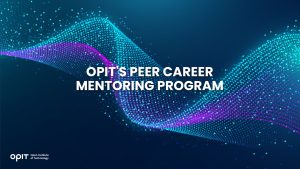
The Open Institute of Technology (OPIT) is the perfect place for those looking to master the core skills and gain the fundamental knowledge they need to enter the exciting and dynamic environment of the tech industry. While OPIT’s various degrees and courses unlock the doors to numerous careers, students may not know exactly which line of work they wish to enter, or how, exactly, to take the next steps.
That’s why, as well as providing exceptional online education in fields like Responsible AI, Computer Science, and Digital Business, OPIT also offers an array of career-related services, like the Peer Career Mentoring Program. Designed to provide the expert advice and support students need, this program helps students and alumni gain inspiration and insight to map out their future careers.
Introducing the OPIT Peer Career Mentoring Program
As the name implies, OPIT’s Peer Career Mentoring Program is about connecting students and alumni with experienced peers to provide insights, guidance, and mentorship and support their next steps on both a personal and professional level.
It provides a highly supportive and empowering space in which current and former learners can receive career-related advice and guidance, harnessing the rich and varied experiences of the OPIT community to accelerate growth and development.
Meet the Mentors
Plenty of experienced, expert mentors have already signed up to play their part in the Peer Career Mentoring Program at OPIT. They include managers, analysts, researchers, and more, all ready and eager to share the benefits of their experience and their unique perspectives on the tech industry, careers in tech, and the educational experience at OPIT.
Examples include:
- Marco Lorenzi: Having graduated from the MSc in Applied Data Science and AI program at OPIT, Marco has since progressed to a role as a Prompt Engineer at RWS Group and is passionate about supporting younger learners as they take their first steps into the workforce or seek career evolution.
- Antonio Amendolagine: Antonio graduated from the OPIT MSc in Applied Data Science and AI and currently works as a Product Marketing and CRM Manager with MER MEC SpA, focusing on international B2B businesses. Like other mentors in the program, he enjoys helping students feel more confident about achieving their future aims.
- Asya Mantovani: Asya took the MSc in Responsible AI program at OPIT before taking the next steps in her career as a Software Engineer with Accenture, one of the largest IT companies in the world, and a trusted partner of the institute. With a firm belief in knowledge-sharing and mutual support, she’s eager to help students progress and succeed.
The Value of the Peer Mentoring Program
The OPIT Peer Career Mentoring Program is an invaluable source of support, inspiration, motivation, and guidance for the many students and graduates of OPIT who feel the need for a helping hand or guiding light to help them find the way or make the right decisions moving forward. It’s a program built around the sharing of wisdom, skills, and insights, designed to empower all who take part.
Every student is different. Some have very clear, fixed, and firm objectives in mind for their futures. Others may have a slightly more vague outline of where they want to go and what they want to do. Others live more in the moment, focusing purely on the here and now, but not thinking too far ahead. All of these different types of people may need guidance and support from time to time, and peer mentoring provides that.
This program is also just one of many ways in which OPIT bridges the gaps between learners around the world, creating a whole community of students and educators, linked together by their shared passions for technology and development. So, even though you may study remotely at OPIT, you never need to feel alone or isolated from your peers.
Additional Career Services Offered by OPIT
The Peer Career Mentoring Program is just one part of the larger array of career services that students enjoy at the Open Institute of Technology.
- Career Coaching and Support: Students can schedule one-to-one sessions with the institute’s experts to receive insightful feedback, flexibly customized to their exact needs and situation. They can request resume audits, hone their interview skills, and develop action plans for the future, all with the help of experienced, expert coaches.
- Resource Hub: Maybe you need help differentiating between various career paths, or seeing where your degree might take you. Or you need a bit of assistance in handling the challenges of the job-hunting process. Either way, the OPIT Resource Hub contains the in-depth guides you need to get ahead and gain practical skills to confidently move forward.
- Career Events: Regularly, OPIT hosts online career event sessions with industry experts and leaders as guest speakers about the topics that most interest today’s tech students and graduates. You can join workshops to sharpen your skills and become a better prospect in the job market, or just listen to the lessons and insights of the pros.
- Internship Opportunities: There are few better ways to begin your professional journey than an internship at a top-tier company. OPIT unlocks the doors to numerous internship roles with trusted institute partners, as well as additional professional and project opportunities where you can get hands-on work experience at a high level.
In addition to the above, OPIT also teams up with an array of leading organizations around the world, including some of the biggest names, including AWS, Accenture, and Hype. Through this network of trust, OPIT facilitates students’ steps into the world of work.
Start Your Study Journey Today
As well as the Peer Career Mentoring Program, OPIT provides numerous other exciting advantages for those who enroll, including progressive assessments, round-the-clock support, affordable rates, and a team of international professors from top universities with real-world experience in technology. In short, it’s the perfect place to push forward and get the knowledge you need to succeed.
So, if you’re eager to become a tech leader of tomorrow, learn more about OPIT today.
Have questions?
Visit our FAQ page or get in touch with us!
Write us at +39 335 576 0263
Get in touch at hello@opit.com
Talk to one of our Study Advisors
We are international
We can speak in:

